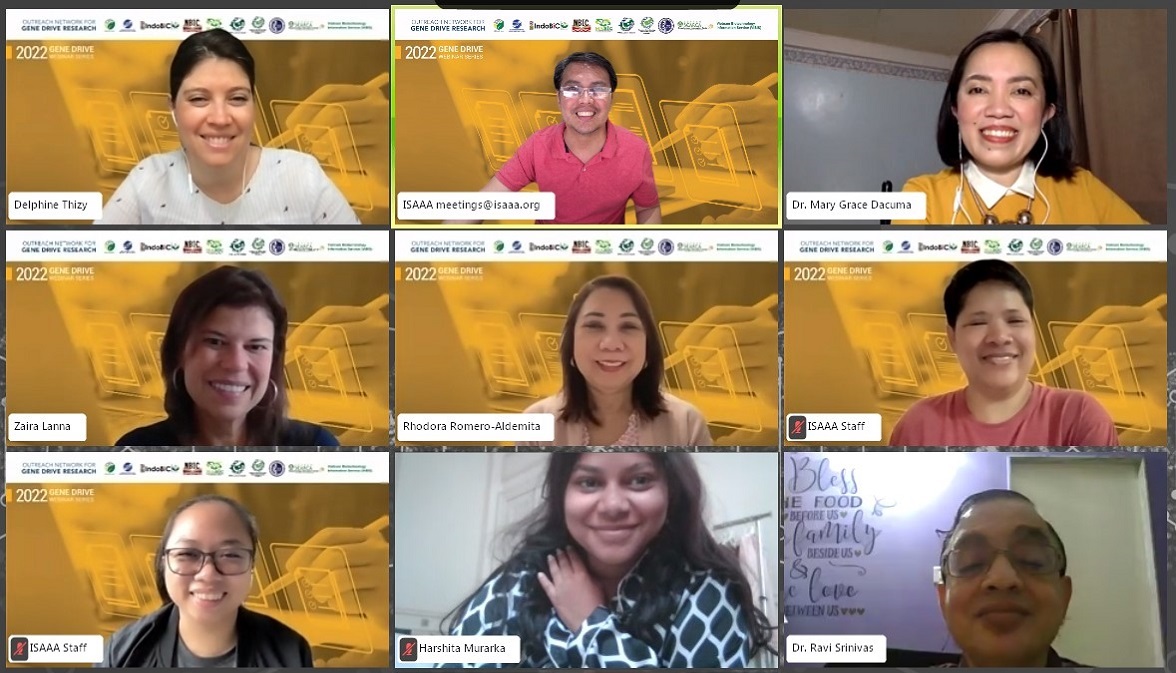
Socio-economic Impact Assessment Complements Risk Assessment of Gene Drive Organisms, According to Experts
August 31, 2022| |
ISAAA Inc., the Outreach Network for Gene Drive Research , and the ISAAA Biotechnology Information Centers Network conducted the webinar Integrating social, economic and health aspects into the decision-making process on July 28, 2022, via Zoom. It is the third and final part of the 2022 Gene Drive Webinar Series. The webinar aimed to give an overview of the different dimensions of gene drive impact and risk assessments, including environmental and socio-economic aspects.
Dr. Rhodora Romero-Aldemita, ISAAA Inc. Executive Director, facilitated the opening of the webinar by stating the objectives and a brief background about the activity. She also laid out the housekeeping rules and introduced the moderator, Dr. Mary Grace Dacuma of the Institute of Biological Sciences at the University of the Philippines Los Baños. Dr. Dacuma then took over and welcomed the attendees. She also provided brief backgrounds of the resource speakers, starting with Dr. Krishna Ravi Srinivas, a Senior Fellow & Consultant with Research & Information System for Developing Countries (RIS) in New Delhi, India. This was followed by the introduction of Ms. Delphine Thizy, Stakeholder Engagement Senior Advisor of Target Malaria.
Dr. Ravi Srinivas talked about the role of socio-economic impact (SEI) assessment and how it complements environmental risk assessment. He started his presentation by mentioning the provision about socio-economic considerations in the Cartagena Protocol on Biosafety then proceeded to define socio-economic considerations and impact. He also explained its five dimensions namely: social, economic, cultural/ethical/religious, ecological-related, and health. He later on identified the issues encountered during implementation, and its merits and limitations. Dr. Ravi ended his talk by relating all three to the conduct of evaluation and assessment of genetically modified organisms and gene drives.
The second speaker, Ms. Delphine Thizy, explained how to assess gene drive's potential social, economic, and health impacts and how it needs to be done on a case-by-case basis since it is dependent on the specific project being carried out. She mentioned that careful consideration about the impact of the organism itself, the impact of the protocol activities, and the impact of the intended outcome should not be overlooked. Another factor that must be included is the possible alternatives to gene drive and its effects. Lastly, she highlighted how impact assessments can complement environmental risk assessment if the two are done in parallel with each other.
The webinar ended with the closing remarks by Dr. Romero-Aldemita, wherein she concluded both the webinar and the 2022 webinar series. She mentioned how gene drive research is progressing in the fields of agriculture, human health, and invasive species mitigation, and that the webinar further helped the public to understand how the technology works and is assessed in preparation for future implementation. Lastly, she highlighted that the knowledge gained from the webinar will help stakeholders make informed decisions on the development and application of gene drive tools.
A more comprehensive summary of the presentations can be found in the Science Speaks blog. The webinar is also available for public viewing in the ISAAA Webinars page and the ISAAA.org YouTube channel. Subscribe to the Crop Biotech Update to stay updated about the developments of gene drive research through the Gene Drive Supplement.
| |
You might also like:
- Assessing the Socio-economic and Health Impacts of Emerging Technologies
- What are the Different Types of Gene Drive?
- Are We Ready to Conduct Risk Assessment on Gene Drive Technologies?
Biotech Updates is a weekly newsletter of ISAAA, a not-for-profit organization. It is distributed for free to over 22,000 subscribers worldwide to inform them about the key developments in biosciences, especially in biotechnology. Your support will help us in our mission to feed the world with knowledge. You can help by donating as little as $10.
-
See more articles:
-
Gene Drive Supplement (August 31, 2022)
- New Policy Brief Calls for Science-based and Case-by-case Risk Assessment of Gene Drives
- Socio-economic Impact Assessment Complements Risk Assessment of Gene Drive Organisms, According to Experts
- Scientists Turn to Gene Editing to Manage Invasive Species
- Modeling Study Features Safe, Confined Gene Drive Using Wolbachia Cytoplasmic Alleles
- Study Helps Define Target Organisms of Gene Drive in Species Complexes
- Impact of Combining Gene Drive and Traditional Vector Controls in Eliminating Malaria
-
Read the latest: - Biotech Updates (December 17, 2025)
- Gene Editing Supplement (December 17, 2025)
- Gene Drive Supplement (February 22, 2023)
-
Subscribe to BU: - Share
- Tweet

